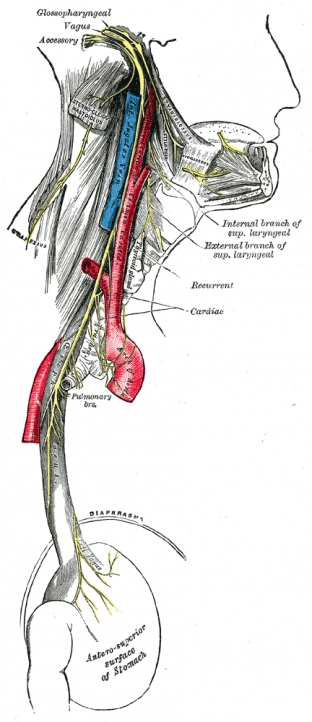When was the last time you had to face a stressful situation with dignity? Have you completed this task? Every day there is more and more evidence that everyday attitudes and behaviors can create a positive snowball effect through the activation of the feedback loop associated with human vagus nerve stimulation.
That is why the editors of Estet-portal decided to tell you about useful habits that will help maintain the tone of the vagus nerve and allow you to maintain calm, composure and composure in stressful situations.
- Key signs of healthy vagal tone
- What is the vagus nerve
- Vagus nerve stimulation as a way to stay calm in a difficult stressful situation
Key signs of healthy vagal tone
Healthy vagus nerve tone is indicated by a slight increase in heart rate as you inhale and a decrease as you exhale. Deep diaphragmatic breathing – with a deep and slow exhalation – the key to stimulate the vagus nerve and slow down the heart rate, lower blood pressure, mainly under tension and pressure. A high vagal tone is associated with mental and physiological health. Conversely, low vagal tone is accompanied by inflammation, bad mood, feelings of loneliness, and even heart attacks.
Industrious athletes are known to have higher vagal tone as they engage in aerobic breathing exercises that lower their heart rate.
The health of the heart is directly related to vagus nerve stimulation, since during the latter, the production of a substance called "vagus nerve substance" is triggered; or, scientifically speaking, acetylcholine. By the way, this substance is the first neurotransmitter discovered by scientists.
Acetylcholine is by nature a tranquilizer that is injected into the body with just a few deep breaths and slow exhalations. You can consciously regulate the action of the vagus nerve to calm down when necessary. Awareness of this fact is enough to reduce the fear of fear itself and to get out of stressful situation with dignity.
What is the vagus nerve
The vagus nerve got its name because a large number of branches depart from its trunk, located in the cerebellum, as well as the brainstem, which reaches the organs located at the very bottom of the abdominal cavity, affecting the main large organs in its path.
The vagus nerve constantly sends sensitive information about the state of the body's organs to the brain. In fact, 80-90% of the nerve fibers in the vagus nerve are dedicated to transmitting information from the internal organs to the brain.

Your vagus nerve – it is the commander-in-chief who helps to keep calm in stressful situations. The autonomic nervous system consists of two diametrically opposed systems that engage in a kind of "tug of war" that provides the body with the opportunity to maintain homeostasis.
The sympathetic nervous system is aimed at accelerating the work of the body, performing the function of a kind of gas pedal – it stimulates the production of adrenaline and cortisol in response to stress. The parasympathetic nervous system performs the opposite function. The vagus nerve is the central control point of the parasympathetic nervous system. It is a kind of brake that slows down the body and uses neurotransmitters (acetylcholine and GABA) to reduce heart rate, blood pressure and slow down organs.
Unfortunately, the reflex reactions of the vagus nerve can play a cruel joke on a person. Every time you wind yourself up before an important event, are nervous or worried, the vagus nerve perceives this as a danger, which reinforces such negative reactions.
All the physical symptoms of fear of possible failure – palpitations, sweaty palms, dry mouth, discomfort in the abdomen, jitters – result of the vagus nerve. Fortunately, you can control the vagus nerve to keep you calm in Vagus nerve stimulation as a way to stay calm in difficult stressful situations
- Visualization of the vagus nerve
- Constant Practice
The more you think about something, the more unsettled your body's reaction is. It's called analysis paralysis.
- Balance between skill and task
Come up with tasks that don't cause much fear, but don't make you bored.
- Reconsider your priorities and values

- Use neuroplasticity to develop positive thinking
- Daily physical activity

There is a hypothesis that stress leads to an imbalance in the autonomic nervous system (insufficient activity of the parasympathetic nervous system and increased activity of the sympathetic nervous system), as well as insufficient activity of the inhibitory neurotransmitter GABA.
Eastern and Western medicine have merged in yoga. As you know, yoga is able to fight the imbalance of the nervous system associated with stress.
- Anxiety is contagious: avoid anxious people
If this is not possible (for example, in waiting rooms, before an interview or exam), use headphones. Turn on your favorite music, close your eyes and don't let other people's feelings spill over onto you. In general, protect your vagus nerve from negative vibes in every possible way.

- Cultivate love and kindness in yourself
The biological roots of composure, calmness and equanimity have their biological roots in the vagus nerve and equate to maintaining calmness in stressful situations.
So use your vagus nerve to maintain balance and calmness. He will always help you to be steadfast and maximize your potential.We hope that the above tips will help you use the incredible possibilities of your vagus nerve and stay calm in stressful situations.






Add a comment